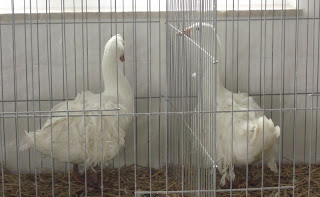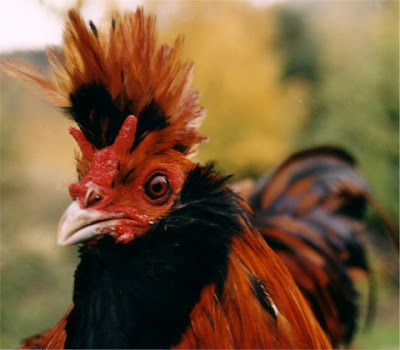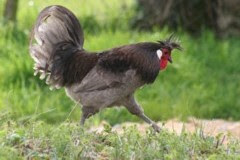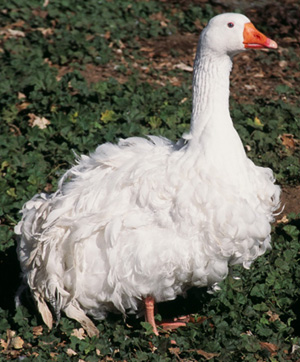 |
| Sebastopol - White Curly Breasted Photo Source: J, Metzer, Metzer Farms (www.metzerfarms.com) |
“Sebastopols look like they just got a curly perm at a hairdressing salon” – Carol Ekarius
| Sebastopols - Curly Breasted White Photo Source: Dave Kozakiewicz |
“Wow! A big ball of fluff! Is it supposed to be like that?” - Those were my thoughts upon first seeing a Sebastopol goose. I wanted to reach out and pet it; it looked so soft and cuddly. The more I researched various poultry breeds, the more I wanted to get some of these unique looking geese.
| Sebastopol - Curly Breasted White Photo Source: Dave Kozakiewicz |
| Sebastopol - Curly Breasted White Photo Source: Dave Kozakiewicz |
What makes the Sebastopol so unique are its curly feathers, giving it that “curly perm” look. The frizzled feathers are the result of a genetic mutation and curl due to the lack of a rigid feather spine or quill. The feathers curl downwards and are up to four times the length of the feathers found in other geese.
If one would imagine the Sebastopol as having regular feathers – no curls at all – they would greatly resemble the Roman breed of geese.
Sebastopols have large, rounded heads, prominent eyes, slightly arched necks, keel-less breasts and dual lobes – the fatty “lumps” that hang down below the abdomen. (A.L.B.C.)
There are two types of Sebastopols; the Curly feather breasted type and the Smooth (regular) feather breasted type. On both types, the plumage on the head and upper two-thirds of the neck is smooth and regular. Orange bills, legs and feet are the standard for both types. White is the historical and most common colour variety found in both types, but there are now Blue, Buff, Cream, Gray, Lavender, Buff Saddleback, Gray Saddleback and Splash varieties found in both Curly and Smooth breasted types. In White colour varieties, the eyes are a bright blue while with the Buff colour, the eyes are brown.
 |
| Roman Goose Photo Source: Lou B. |
Sebastopols have large, rounded heads, prominent eyes, slightly arched necks, keel-less breasts and dual lobes – the fatty “lumps” that hang down below the abdomen. (A.L.B.C.)
There are two types of Sebastopols; the Curly feather breasted type and the Smooth (regular) feather breasted type. On both types, the plumage on the head and upper two-thirds of the neck is smooth and regular. Orange bills, legs and feet are the standard for both types. White is the historical and most common colour variety found in both types, but there are now Blue, Buff, Cream, Gray, Lavender, Buff Saddleback, Gray Saddleback and Splash varieties found in both Curly and Smooth breasted types. In White colour varieties, the eyes are a bright blue while with the Buff colour, the eyes are brown.
 |
| Sebastopol - Smooth Breasted White Photo Source: Dave Kozakiewicz |
 |
| Sebastopols - Smooth Breasted White Pair Photo Source: F. L. |
 |
| Sebastopols - Smooth Breasted Gray Saddleback Photo Source: F. L. |
 |
| Sebastopols - Curly Breasted White, Gray and Gray Saddleback Photo Source: Dave Kozakiewicz |
The Curly breasted type has its curled feathers commencing on the lower third of the neck and continuing on down on the breast and underbody. The feathers on the back, wings and tail are soft and curl downwards almost touching the ground in outstanding individuals (Holderread).
“Smooth breasted Sebastopols that have the proper feather pattern (as Standardized in Europe, where they can and do show them) have long wide streamers coming off the back/shoulders and a waterfall of streamers in front of the thighs. Wings are completely 100% normal. The wing flights and totally smooth breasts DQ them under the APA SOP. Young and/lightly built birds can and have become airborn though usually there is enough bulk, especially as adults, to make that difficult at best.” - Dave Kozakiewicz
The Sebastopol is classified as a Medium Goose by the American Poultry Association Standards with weights as follows:
Old Gander: 14 lbs Old Goose: 12 lbs.
Young Gander: 12 lbs. Young Goose: 10 lbs.
Only Curly breasted White Sebastopols are currently recognized for show in North America. Defects include straight flights, wing feathers protruding from the body and the absence of curled feathers on the underbelly and back under the folded wings. (American Standard of Perfection, 1998)
In Germany, only Smooth breasted White Sebastopols are recognized for show.
They are classified as a Light Breed by the German Standards with stipulated weights being 5.0 – 6.0 kg. for Ganders and 4.5 – 5.5 kg. for the Goose.
 |
| Sebastopols - Smooth Breasted White Pair as Per German Standards Photo Source: SV Deutscher Gänsezüchter von 1907 |
They are classified as a Light Breed by the German Standards with stipulated weights being 5.0 – 6.0 kg. for Ganders and 4.5 – 5.5 kg. for the Goose.
Merkmale: Typ einer Landgans, kurzer Rumpf, volle runde Brust, kleiner runder Kopf und kurz geschlossener Schwanz, Gefieder ein-farbig weiß,
Körpermasse: Gans 4,5 - 5,0 kg, Ganter 5,0 - 6,0 kg
Besonderheit: Verlängerte spiralig gedrehte Federn am Oberkörper
 |
| Sebastopols - Smooth Breasted White Pair Photo Source: Rassegefluegel.de |
In Britain, BOTH Curly breasted and Smooth breasted (sometimes called the Frizzle and Trailing Frizzle) types in White and Buff are recognized for exhibition. They are classified as a Light Breed with body weights of 5.4 -7.3 kg. (12 – 16 lbs.) for the Gander and 4.5 – 6.3 kg. (10 – 14 lbs.) for the Goose.
History of Sebastopol Geese
Sebastopol Geese have a long, but somewhat unknown and slightly disputed history. They are descendents of the European Graylag and in body shape, closely resemble the Roman breed of geese.
It is believed that they were developed in South Eastern Europe along the Danube River and the Black Sea. In fact, by the early 1800’s, Sebastopols could be found in all of the countries surrounding the Black Sea where they were bred specifically for the soft curly feathers to be used in pillows, quilts and comforters; however, they did not make it to Western Europe until the mid to late 1800’s.
The first Sebastopols in Western Europe are believed to be those which were sent from the sea port of Sebastopol (now in the Ukraine) to Britain by Mr. John Harvey, esq., who was apparently yachting on the Black Sea. At a port of call, Mr. Harvey saw some of Sebastopols and became quite taken by them. He arranged for some to be shipped back home and he is therefore credited with bringing the first birds to Britain.
From the London Times (Mar. 28, 1878):
We lately announced the death of Mr John Harvey, of Ickwellbury, Bedfordshire, and of Finnenley Park, Yorkshire, J.P. & D.L. and Chairman of the Quarter Sessions, and its High Sheriff, Beds, who died at 9 Cavendish Sqr, London, on the 7th inst. after long illness.
The representative of one of the most ancient families of Gt Britain, and a large landed proprietor in several counties, Mr Harvey may be cited as the model of an Engllish country gentleman. In public life as a Magistrate and chairman of the Quarter Sessions, Mr Harvey's career was one of the highest usefulness and influence, and it will be difficult, if not impossible, to replace him. Few men have succeeded in doing so much good to their suffereing fellow creatures, for it is mainly due to Mr Harvey's exertions that the condition of county lunatic asylums was early brought to his notice, and after years of untiring labour he had the satisfaction of seeing better building erected and a better mode of treating the insane adopted in all of those counties in which he had influence.
For many years Mr Harvey had been well known as an enterprising Yachtsman, and was one of the oldest members of the Cowes Royal Yacht Squadron. In his yacht "The Claymore" he visited most parts of the world,
Mr Harvey married Annie, daughter of Mr Henry Tennant, of Cadoxton Hall, Glamorganshire, and leaves two children, - a son who is on the staff of the Governor General of Canada, and a daughter.
Mr John Harvey was a descendant of the same family of Harvey as of the Noble House of Bristol (Marquies), who married his cousin, daughter of Audley Harvey, Esq of Cole Park, Malmsbury, Wilts. He was born Nov 14, 1815; married in 1848. His son is named John Audley Harvey, 42nd Highlanders; daughter named Beatrice Susan Audley.
- Wells - Campbell Family Tree Genealogy Pages
It is believed that the birds arrived in Britain between 1857 and 1859. They were known as Danubians due to the fact of that great numbers of them were raised along the Daube. (Ashton ,1999) William Bernhardt Tegetmeier, a British naturalist, writer and journalist was the first to document the presence of “Danubians” in Britain and gave the credit to Mr. Harvey, esq. for introducing them. They were also mentioned in Lewis Wright’s “The Book of Poultry” (1st Edition) in 1872.
Another account mentions the belief that they originated in the southern areas of Russia or Turkey and that they were introduced into Britain in 1859:
“Among some of the earlier imported birds a few had a small tuft on the top of the head, and we are informed that many birds having that decoration are to be found in Southern Russia and Asia Minor.” – Brown (1906)
According to the Poultry Club of Great Britain, the history of the introduction of Sebastopols into Great Britain is somewhat different:
“They were introduced into the U.K. by the diplomat Lord Dufferin in 1860, when he was sent to sort out problems in countries surrounding the Black Sea.” - www.poultryclub.org
This is disputed with the fact that in February 1860, before Lord Dufferin went to the Baltic area, some Sebastopol were presented to the Zoological Society by Mr. Bartlett, a poultry fancier. (Domestic Waterfowl Club of Great Britain)
What is known and agreed upon is that in 1860, the British public was introduced to the “Danubians” at the London Poultry Exhibition held at the Crystal Palace and they were subsequently written up and described in the ‘Illustrated London News’. The birds were shown by Mr. Harvey D. Bayly under the name of “Sebastopol”, in reference to the port from which they were exported. [‘Journal of horticulture, cottage gardener and country gentlemen’ (1861), University of Mass., Amherst Libraries).
The name “Danubian” for the breed can be first referenced back to Ireland in 1863, and both it and “Sebastopol” were used synonymously when referring to the breed until the early 1900’s. The name “Danubian” was used in E. Brown’s 1906 The Poultry Book, and was thus was given precedence over “Sebastopol”. However, in a 1912 revised edition of “The Book of Poultry” by S. H. Lewer, they had once again became known as “Sebastopols”, probably due to the fact that The Poultry Club (of Great Britain) had included them as such in their 1910 Breed Standards and have thereafter held the name. The Spanish and Italians refer to the breed as Danubio, the French and Belgians l’Oie frisée du Danube (Frizzled Goose of the Danube), and the Germans Lockengans (Curly goose) or Struppgans (Shaggy goose).
The Sebastopol made its way back to mainland Europe (France and Germany) from Britain. In France, where they are known as l’Oie frisée du Danube, they were first exhibited and received broad public admiration at l'exposition universelle de 1889 in Paris. This World’s Fair was held during the 100th Anniversary of the Storming of the Bastille.
In Germany, their history goes back to the mid to late 1860’s with the recognized Standards set prior to the formation of the German Goose Association in 1907. (SV Deutscher Gänsezüchter von 1907).
In Germany, their history goes back to the mid to late 1860’s with the recognized Standards set prior to the formation of the German Goose Association in 1907. (SV Deutscher Gänsezüchter von 1907).
The history of the Sebastopol in North America is even more obscure. It is believed that they first arrived here in the late 1800’s and then supposedly they were then bred with Embden geese to increase their size (Weir, Harrison, Johnson, W.G., Brown G.O. - 1904)
Depending upon sources, the American Poultry Association either recognized the breed in 1938 (Malone, et. al., 1998) or 1939 (Ekarius 2007).
Keeping Sebastopols
Sebastopols are said to be quite calm with exceptional personalities. When handled carefully, they have a quiet and pleasant nature (Holderread, 1981).
They can be quite the conversation piece when people first see them and a group of them is a real magnificent scene. They are excellent show birds, but also make a fine table bird.
 |
| "Me and My Geese" - Victoria and her Gray Saddleback and White Sebs Photo Source: Victoria O. |
"...as you can see they are friendly geese and I love my Geese." - Victoria O.
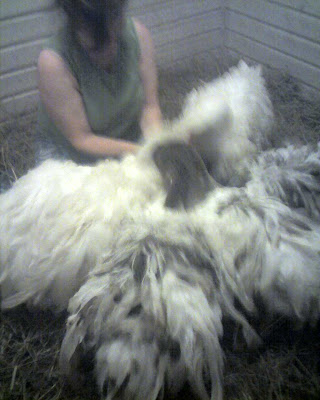 |
| "Flurry of Feathers" - Victoria and her Sebs Photo Source: Victoria O. |
They can be quite the conversation piece when people first see them and a group of them is a real magnificent scene. They are excellent show birds, but also make a fine table bird.
Mr. Dave Kozakiewicz of Hindsight Farm in Ann Arbor, MI. got his birds from the late Mr. W.C. "Bill" Garber of Simcoe, Ontario, Canada. Dave has raised the Garber strain of Sebastopol Geese since 1972. … Dave loves working with these geese and learns more about them every day.
"A good Sebastopol in full feather is just awesome. It can be hard to believe that they are real" says Dave.
- HPBAA.
| Sebastopols - Curly Breasted White Photo Source: Dave Kozakiewicz |
| Sebastopols - Curly Breasted White Photo Source: Dave Kozakiewicz |
Many people believe that keeping Sebastopols clean, especially those long trailing curly feather, is a difficult task so they shy away from them as a breed of choice. In fact, they are quite easy to keep clean if provided with a mud-free environment and water to bathe. This can be provided in the form of a kiddy pool or at the very least, a large bucket of water.
 |
| Sebastopol - White Flock Enjoying Kiddie Pool Photo Source; J. Metzer, Metzer Farms (www.metzerfarms.com) |
Even though they look like delicate balls of fluff, Sebastopols are actually quite hardy. However, care must be taken to provide good shelter from the wet, wind, and extremes of temperature as their feathers are loose and do not lay flat thus do not shed water or provide as much warmth as those of other breeds. Winds can easily fluff up their feathers thus body heat is quickly lost. In very cold weather they might like to spend more time in shelter than other breeds, but they are known to enjoy their baths, even in the cold of winter.
Breeding Sebastopols
“Whenever a domestic animal is selected for an unusual characteristic, great care must be taken to insure that vigor and fertility of breeding stock is not overlooked.” (ALBC)
As with most poultry for breeding purposes, the primary selection should be for healthy, robust individuals showing the proper size for the breed. When selecting Sebastopols, one should look for birds with well-curled breast feathers, flexible flight feathers, and back and tail plumes that are long, broad and spiraled. Avoid selecting breeding stock with crooked toes and slipped wings (Holderread, 1981).
It seems that even though ganders can be mated with one to four geese, low fertility is often experienced with this breed. Females normally produce 25-35 eggs annually.
“Fertility seems to be a problem with most Sebastopols, along with lower than normal egg production. Fertility is adequate early in the season (and they do seem to come into production earlier than most breeds) but quickly drops off. Oftentimes we will have no fertile eggs the last three weeks of production in the spring.” (J. Metzer)
Clipping the long plumes of the back and tail and the feathers around the vent is sometimes helpful (Holderread, 1981).
The mutation causing the curly feathers is sometimes referred to as the “Sebastopol Gene”. Birds that have a “double dosage” of this gene are Curly breasted whereas those that are Smooth breasted carry only one “dose” of the Sebastopol gene. Only Curly breasted breed 100% true and when breeding two Smooth breasted individuals together, three sorts of offspring are possible: Curly breasted, Smooth Breasted, and totally smooth. (C. & M. Ashton)
“You will see so called smooth breasted birds being offered as the best breeding tool ever that have no or very little mutated feather. This is not what a smooth breasted should be and those offering such birds are either misleading the novice or ignorant. Dave Holderread has done more with them than anyone and said that at least in theory it is possible to breed smooth BIRDS” - Dave Kozakiewicz
Natural incubation lasts for a period of 30 days usually with one clutch a year of about 10 - 15 eggs. Young birds may start with a few gray feathers but gradually lose them until they are pure white at about 20 weeks, after their final set of feathers develops. (Metzer)
 |
| Sebastopol - White Gosling Photo Source; J. Metzer, Metzer Farms (www.metzerfarms.com) |
Sources
Metzer Farms (www.metzerfarms.com)
– White Curly breasted Sebastopol
I would like to thank Dave Kozakiewicz and Victoria O. for all of the valuable information and pictures.
If anyone would like their name to be listed as a source please contact Cameron at mcattack_ca@yahoo.com Also, if you have any pictures you would like to share or have any additional information, please contact Cameron at the above address.


